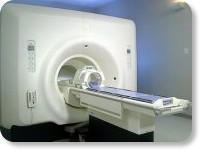 | Info
Sheets |
| | | | | | | | | | | | | | | | | | | | | | | | |
 | Out-
side |
| | | | |
|
| | | | |
Result : Searchterm 'Fast Scanning' found in 1 term [ ] and 2 definitions [ ] and 2 definitions [ ], (+ 6 Boolean[ ], (+ 6 Boolean[ ] results ] results
| 1 - 5 (of 9) nextResult Pages :  [1] [1]  [2] [2] |  | |  | Searchterm 'Fast Scanning' was also found in the following service: | | | | |
|  | |  | |  |  |  |
| |
|
(HS) A method in which approximately one half of the acquisition matrix in the phase encoding direction is acquired. Half scan is possible because of symmetry in acquired data. Since negative values of phase encoded measurements are identical to corresponding positive values, only a little over half (more than 62.5%) of a scan actually needs to be acquired to replicate an entire scan.
This results in a reduction in scan time at the expense of signal to noise ratio. The time reduction can be nearly a factor of two, but full resolution is maintained.
Half scan can be used when scan times are long, the signal to noise ratio is not critical and where full spatial resolution is required. Half scan is particularly appropriate for scans with a large field of view and relatively thick slices; and, in 3D scans with many slices.
In some fast scanning techniques the use of Half scan enables a shorter TE thus improving contrast. For this reason, the Half scan parameter is located in the contrast menu.
More information about scan time reduction; see also partial fourier technique. | |  | |
• View the DATABASE results for 'Half Scan' (4).
| | | | |
|  | |  |  |  |
| |
|
| |  | |
• View the DATABASE results for 'Partial Averaging' (4).
| | | | |
|  |  | Searchterm 'Fast Scanning' was also found in the following service: | | | | |
|  |  |
| |
|

(Signa VH/i 3.0T)
With GE Healthcare
leading-edge technology in ultra-high-field imaging. The 3 T VH/i provides a platform for advanced applications in radiology, cardiology, psychology and psychiatry. Real-time image processing lets you acquire multislice whole brain images and map brain functions for research or surgical planning. And the 3 T Signa VH/i is flexible enough to provide clinicians with high performance they require. It can provide not only outstanding features in brain scanning and neuro-system research, but also a wide range of use in scanning breasts, extremities, the spine and the cardiovascular systems.
Device Information and Specification CLINICAL APPLICATION Whole body
T/R quadrature head, T/R quadrature body, T/R phased array extremity (opt) SE, IR, 2D/3D GRE, FGRE, RF-spoiled GRE, FSE, Angiography: 2D/3D TOF, 2D/3D phase contrast vascular IMAGING MODES Single, multislice, volume study, fast scan, multi slab, cine, localizer 100 Images/sec with Reflex100 MULTISLICE 100 Images/sec with Reflex100 2D 0.5-100mm in 0.1mm incremental 128x512 steps 32 phase encode H*W*D 260cm x 238cm x 265cm POWER REQUIREMENTS 480 or 380/415, 3 phase ||
COOLING SYSTEM TYPE Closed-loop water-cooled grad. Less than 0.14 L/hr liquid He | |  | |
• View the DATABASE results for 'Signa 3.0T™' (2).
| | | | |
|  | |  |  |  |
| |
|

From Esaote S.p.A.;
Esaote introduced the new G-SCAN at the RSNA in Dec. 2004. The G-SCAN covers almost all musculoskeletal applications including the spine. The tilting gantry is designed for scanning in weight-bearing positions. This unique MRI scanner is developed in line with the Esaote philosophy of creating high quality MRI systems that are easy to install and that have a low breakeven point.
Device Information and Specification
SE, GE, IR, STIR, TSE, 3D CE, GE-STIR, 3D GE, ME, TME, HSE
100 up to 350 mm, 25 mm displayed
POWER REQUIREMENTS
100/110/200/220/230/240 V
| |  | |
• View the DATABASE results for 'G-SCAN' (3).
| | | | |
|  | |  |  |
|  | |
|  | 1 - 5 (of 9) nextResult Pages :  [1] [1]  [2] [2] |
| |
|
| |
 | Look
Ups |
| |